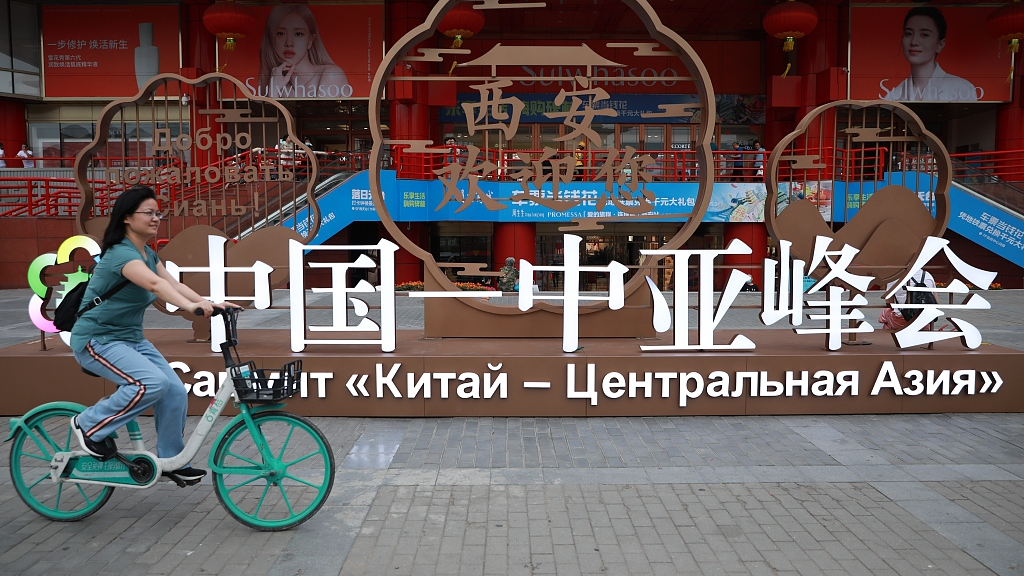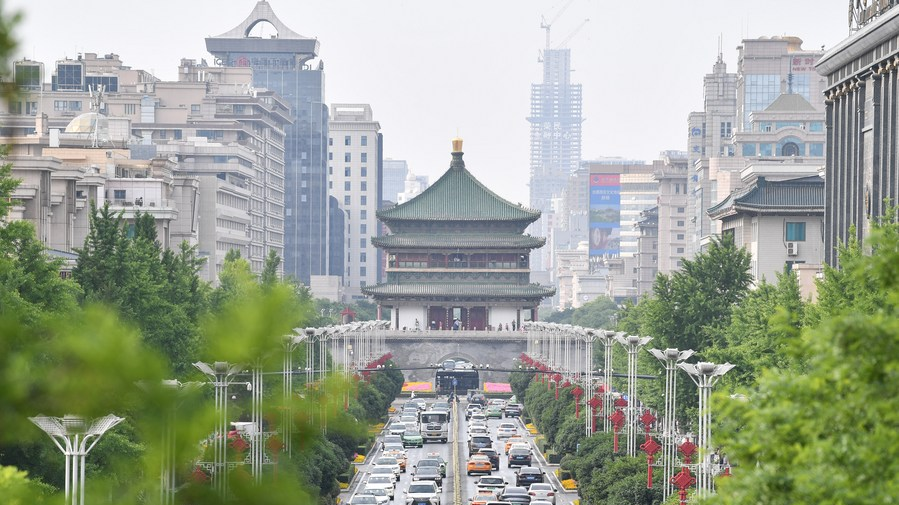
People ride bicycles past electronic billboards displayed around the Bell Tower in Xi'an, capital of northwest China's Shaanxi Province, May 17, 2023. /CFP
People ride bicycles past electronic billboards displayed around the Bell Tower in Xi'an, capital of northwest China's Shaanxi Province, May 17, 2023. /CFP
Editor's note: Li Yonghui is a research fellow of the Institute of Russian, Eastern European and Central Asian Studies of the Chinese Academy of Social Sciences. The article reflects the author's opinions and not necessarily the views of CGTN.
The China-Central Asia Summit successfully wrapped up. Major political documents were issued during the summit, including Chinese President Xi Jinping's keynote speech, the Xi'an Declaration, and the List of Outcomes of the China-Central Asia Summit. These documents highlight the significant consensus between China and Central Asia regarding future cooperation. They establish a cooperative mechanism for the future development of China and Central Asia, setting the direction of cooperation and outlining the prospects for cooperation, which received overwhelming support from all countries.
The summit is an important event that connects the past and the future in China's neighborhood diplomacy, drawing up blueprints for future China-Central Asia cooperation. It opens a new chapter in China-Central Asia relations, one in which China and the five Central Asian countries will jointly build a community with a shared future under the guidance of the heads of state. The summit is marked by the following characteristics.
Firstly, it's led by the heads of states. The summit has put in place a mechanism that allows the leaders of China and Central Asian countries to meet every two years. This demonstrates their commitment to steering their nations' development from a higher vantage point, fostering mutual support, and bolstering strategic partnerships between China and Central Asia. The institutionalization of this summit enables balanced and smooth development of bilateral relations, allows for timely responses to external challenges, and facilitates participation in regional and global economic governance at a higher level. It can also strengthen coordination and help China and Central Asian countries to make contributions to regional and global development.
Secondly, it's marked by deep and extensive cooperation. The three political documents suggest a deepening and broadening of cooperation between China and Central Asian countries, based on which a China-Central Asia community with a shared future will be jointly built. The List of Outcomes comprises 54 consensuses and initiatives, including 19 cooperation mechanisms established on the multilateral cooperation platforms proposed by China. Nine multilateral cooperation documents were signed within the framework of the summit. The cooperation extends to various sectors, encompassing security, industry and investment, digital economy and trade, infrastructure construction, agriculture, customs, animal and plant quarantine, business council cooperation, and cultural exchange.
Thirdly, it serves as a guiding beacon. A key agenda was to further promote the joint building of the Belt and Road Initiative (BRI) with high standards. During his visit to Kazakhstan in September 2013, President Xi formally proposed the BRI. This initiative, built on the principles of extensive consultation, joint contribution, and shared benefits, represents a significant contribution by China to the global community. It offers a fresh approach to address global economic governance challenges and explore regional integration, providing a valuable public good for the world.

A view of the Bell Tower in Xi'an, northwest China's Shaanxi Province, May 15, 2023. /Xinhua
A view of the Bell Tower in Xi'an, northwest China's Shaanxi Province, May 15, 2023. /Xinhua
The BRI is inextricably linked to Central Asia and has emerged as an international public good and a platform for international cooperation welcomed by Central Asian countries. The BRI is of strategic significance to the cooperation between China and Central Asian countries, as it explores the potential for economic complementarity of all parties involved, deepens practical cooperation in various fields, and forms a novel cooperation paradigm characterized by deep complementarity and great mutual benefit.
President Xi's speech laid out "four principles" and "eight proposals," illuminating the central tenets of China's relations with Central Asian countries and pointing out the primary direction for future development. The first principle is mutual assistance: it means fostering an environment of trust and supporting each other's development path, sovereignty, and territorial integrity. The second principle is common development: this involves aligning development strategies based on equality, promoting shared growth, and achieving win-win cooperation, particularly through jointly building the BRI with high standards.
The third principle is universal security: this means embracing a holistic view of security, where security is reciprocal and each party's security concerns are taken into consideration and understood. The fourth principle is everlasting friendship, which entails respecting cultural diversity, advocating harmony without uniformity, fostering long-term friendly relations between neighbors and never becoming enemies.
Moving forward, China intends to strengthen the exchange of modernization philosophies and practices with Central Asian countries, align development strategies, create a plethora of opportunities for cooperation, and jointly promote the modernization process of the six countries. This is precisely the cornerstone of building a China-Central Asia community with a shared future.
The world is currently witnessing unprecedented and rapid transformations unseen in a century. Our era is characterized by remarkable changes in the global landscape and the historical trajectory. Positioned at the crossroads between the East and the West, the South and the North, Central Asia — situated at the heart of the Eurasian continent — plays a pivotal role in shaping these dynamics.
For China and Central Asia, the fundamental goal is to maintain regional peace, prosperity, harmony, and connectivity, while safeguarding regional security through various mechanisms. The stronger ties between China and Central Asia will also facilitate better connectivity and inclusivity between Europe and Asia, promoting peace, stability, and development across the Eurasian continent.
(If you want to contribute and have specific expertise, please contact us at opinions@cgtn.com. Follow @thouse_opinions on Twitter to discover the latest commentaries in the CGTN Opinion Section.)